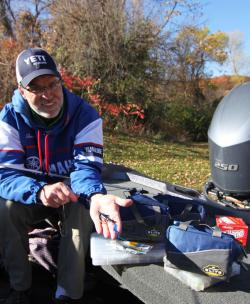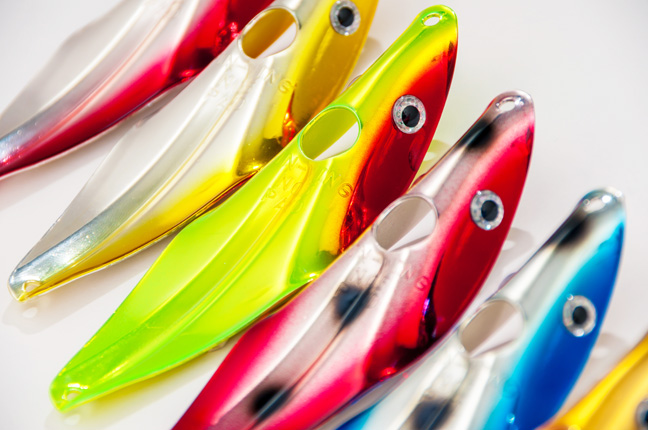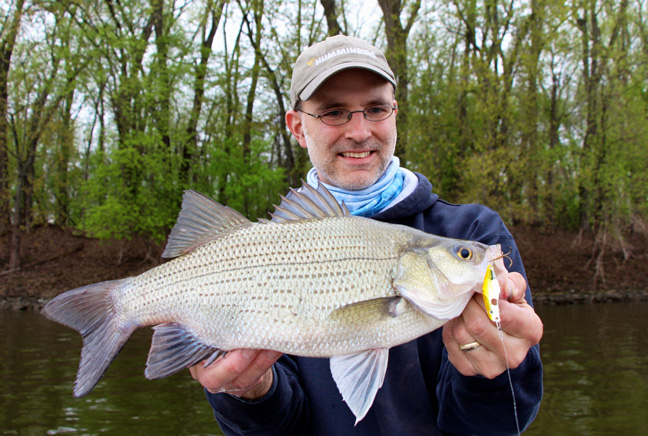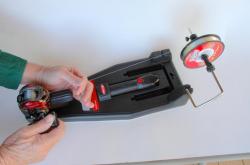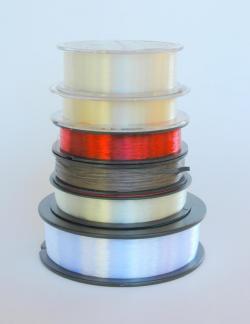When Big Baits Are Best for Bass
How up-sizing can work magic on heavily-pressured waters, especially during “heat fronts”
By Steve Pennaz
from The Fishing Wire
Fish studies confirm that bass can become conditioned through continual exposure to baits. Especially on heavily-pressured waters, bass do learn to avoid baits. Berkley’s Dr. Keith Jones covers the subject in his book Knowing Bass: The Scientific Approach for Catching More Fish. In it, Jones discusses research evidence that suggests bass remember lures for a long time – “for at least up to three months and perhaps much, much longer.”
The challenge for the angler is staying ahead of the curve. One of the best ways is to fish outside of the box, choosing baits the fish have probably never seen before. Or fishing baits that have fallen out-of-favor for newer, trendier baits.
Or simply up-sizing the same baits we already know are effective.
I remember fishing a river system one spring day. We had started early to avoid the crowds, then battled skyrocketing temps throughout the day. I know a lot of anglers like to be on the water during those warm spring days, but I prefer more stable conditions.
Fishing was predictably slow under the changing conditions so I slowed down like you do during a cold front and went to smaller baits while casting to timber and current seams along the bank. We landed four bass running between 1.5 and 2 pounds.
There was another boat working the same bank behind us…with a lone angler in the bow. I saw him hook up a couple times, but didn’t think much of it at the time.
Later, back at the launch, I asked the other angler how he had done. He said he caught five fish, including a 3-pounder and two 4-pound fish flippin’ the same river timber I had fished ahead of him.
I asked him, “What bait where you flippin’?”
His plaintive response: “Power Lizards.”
I hadn’t thought to go larger with my presentation and so this information was striking. But the more I thought about it, the logic behind it was too strong to ignore…how many other anglers would go in this direction during difficult situations like cold fronts or what I call “heat fronts”?
When you get a week of average temps and all of a sudden the temperature sky-rockets into the 80 or 90s (or higher), water temps change drastically. It’s like what happens during a cold front, but in reverse. And the effects on bass and other fish are the same; their movements slow. If you monitor the water temps on your electronics, there are situations where increases can be as much as 8, 10 or even more degrees in a day. Where I live, going from 40-degree overnight air temps to 80 degrees by late afternoon is not uncommon!
When faced with drastic temperature increases, I often hold off fishing my best spots until late in the day when temperatures stabilize somewhat. By this time, the biggest fish with the most mass will have had time to acclimate to the change and will be more active. The bass that do feed during these dramatic shifts in water temperature often look for the biggest meal with the least amount of metabolic effort. Like any host of large amphibians, salamanders and the like.
Still, a lot of anglers are hesitant to fish lizards, thinking they’re only big-fish baits. In reality, a lizard doesn’t appear too large to bass, which typically track prey from behind. The visual cue is only part of the equation. What can really stimulate their feeding or attack response has to do with how they feel that bait. With its many appendages, a lizard displaces more water and produces more vibrations, which the bass picks up via its lateral line.
An angler needs to ask a few questions:
How big of a bait can I get away with on a given body of water? And secondly, what will be most appealing to the biggest fish in a school?
At times it makes sense to start smaller, but there are times when going large is the right move.
If the waters have big fish and lots of pressure, I may start bigger because I can. And for the past couple of years, I’ve been fishing lizards … a lot.
Why more anglers aren’t fishing lizards is a real head-scratcher. But I can relate. The past decade we’ve seen so many new and effective creature-style baits and worm designs hit tackle shelves that it was easy to forget the proven performer.
Big mistake. Lizards worked then — and still do.
Lizard Rigging Tips
When rigging lizards, hooks can make or break your day. I learned long ago that while great for compact, creature baits, EWG-style hooks are not the best choice for Texas-rigging lizards or big worms.
Instead, I use a 5/0 or 6/0 offset worm hook that provides great hook-up ratios and allows the baits to move fluidly, as designed.
Historically, my favorite lizard is the 6-inch PowerBait Power Lizard, although I’m starting to catch a lot of bass on the Gary Klein-designed Havoc Boss Dog, too. But given that bass will often grab lizards and big worms in the middle – rather than inhaling the entire bait – the PowerBait formula really puts the odds in your favor. They simply hold on to the bait longer, giving you more time for a solid hookset.
In terms of color, my favorite is pumpkin with a chartreuse tail, which is based purely on nostalgia; it produced my first giant bass years ago and still works great today. But I also carry black/blue, black, green pumpkin and watermelon.
In terms of line…I fish 10- to 15-lb. Berkley Trilene 100% Fluorocarbon in clear waters; 15- to 17- lb. for stained conditions. And in waters with double-digit bass, I’ll go even heavier. I like the sensitivity you get with fluoro, the fact it sinks, and the near invisibility factor.
Another cool thing about fishing heavy fluoro with lizards or big worms is it decreases the amount of tungsten or lead weight you need to use. You get some sinking factor with the line itself. That means I’ll often fish lizards or big worms weightless in shallow-water (1.5- to 2 feet) situations. Plus, the Berkley PowerBait Power Lizard is pretty bulky in the body. All this adds up to long casts and easy fishability.
Rod & Reel Setup
One of my secrets to fishing lizards is upping the speed. Rather than the typical “lift-drag” Texas rig retrieve, I’ll use a twitch-twitch-reel-reel-shake and repeat. This gets the appendages really pushing water. To those ends, I like a higher-geared baitcaster like the 7.0:1 Abu Garcia Revo MGX.
Pennaz prefers a 5/0 or 6/0 offset worm hook over an EWG for Texas-rigging lizards or big worms. “You’ll get greater hook-up ratios and a more natural bait action,” says Pennaz.Speaking to that reel, it weighs around 5 ounces, which means when combined with a feathery 7’6″ fast action, medium-heavy power Abu Garcia Veracity, you can easily fish these big baits all day without fatigue. Plus, fishing lighter rods and reels gives you better sensitivity…important for detecting bites on the drop.
Parting Words
This season pay attention to drastic temperature swings and fish them like cold fronts in reverse. Size up and try lizards for more and bigger bass, even during difficult situations on pressured waters.
About Steve Pennaz
Steve is one of the most trusted voices in fishing. From 1988 until 2012, he served as Executive Director for the North American Fishing Club, including North American Fisherman magazine, fishingclub.com and the club’s daily enewsletter “Fishin’ Informer.” He’s also hosted several television series, including “North American Outdoors,” “North American Fisherman,” and “Fishing Club Journal.” Pennaz launched Knot Wars, now a successful app on iPhone and Droid. He excels at finding and catching fish on new waters, a skill that now drives “Lake Commandos.”

